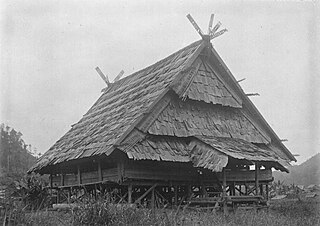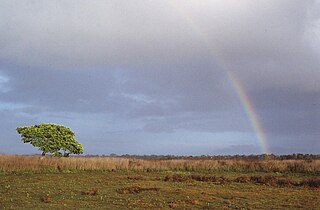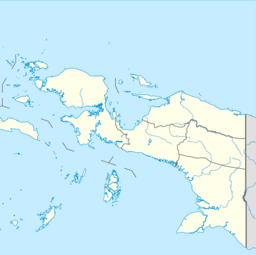
Simalia boeleni is a species of python, a nonvenomous snake in the family Pythonidae. The species is endemic to the mountains of New Guinea. No subspecies are recognized. Its common names include Boelen's python and the black python.

Ekari is a Trans–New Guinea language spoken by about 100,000 people in the Paniai lakes region of the Indonesian province of Central Papua, including the villages of Enarotali, Mapia and Moanemani. This makes it the second-most populous Papuan language in Indonesian New Guinea after Western Dani. Language use is vigorous. Documentation is quite limited.

The fauna of New Guinea comprises a large number of species of mammals, reptiles, birds, fish, invertebrates and amphibians.

Lake Poso is a lake in Central Sulawesi, Indonesia, and the third-deepest lake in Indonesia.
The Wissel Lakes tree frog is a species of frog in the subfamily Pelodryadinae, endemic to West Papua, Indonesia. Its natural habitats are freshwater lakes, intermittent freshwater lakes, and rocky areas.
The Paniai gudgeon is a species of fish in the family Butidae endemic to the Paniai Lakes and their tributaries in West Papua, Indonesia. This species can reach a standard length up to 11.5 cm (4.5 in). It is popularly used as a bait fish.

Oxyeleotris is a genus of sleeper gobies mostly restricted to Australia and New Guinea, though some are found in Southeast Asia.
The Paniai Lakes languages, also known as the Wissel Lakes or Wissel Lakes – Kemandoga River, are a small family of closely related Trans–New Guinea languages spoken in the Paniai Lakes region of the highlands of Western New Guinea in the Paniai Lakes region of Papua. Foley (2003) considers their Trans–New Guinea status to be established.

New Guinea is the world's second-largest island, with an area of 785,753 km2 (303,381 sq mi). Located in Melanesia in the southwestern Pacific Ocean, the island is separated from Australia by the 150-kilometre wide Torres Strait, though both landmasses lie on the same continental shelf, and were united during episodes of low sea level in the Pleistocene glaciations as the combined landmass of Sahul. Numerous smaller islands are located to the west and east. The island's name was given by Spanish explorer Yñigo Ortiz de Retez during his maritime expedition of 1545 due to the resemblance of the indigenous peoples of the island to those in the African region of Guinea.

The Lake Sentarum National Park is a national park protecting one of the world's most biodiverse lake systems, located in the heart of Borneo Island, Kapuas Hulu Regency, West Kalimantan Province, Indonesia. It lies in the upper Kapuas River tectonic basin some 700 kilometres upstream from the delta. The basin is a vast floodplain, consisting of about 20 seasonal lakes, freshwater swamp forest and peat swamp forest. Local people call it as Lebak lebung (floodplain). The National Park is located in the western part of this basin, where three-quarters of the seasonal lakes occur. Approximately half of the park consists of lakes, while the other half consists of freshwater swamp forest.

The Wasur National Park forms part of the largest wetland in Merauke Regency, South Papua, Indonesia and has been one of the least disturbed by human activity. The high value of its biodiversity has led to the park being dubbed the "Serengeti of Papua". The vast open wetland, in particular Rawa Biru Lake, attracts a very rich fauna.
Black Brothers was a well-known West Papuan pop group from Jayapura. The band consisted of five members, led by Andy Ayamiseba. Their music, sung in Tok Pisin, and originally in Indonesian, included influences from reggae and political elements inspired by the Black Power movement. The group went into voluntary exile in Vanuatu in 1979, protesting Indonesian policies in West Papua. They later moved to Papua New Guinea.
The Ayamaru Lakes are a group of lakes found in the west-central part of the Bird's Head Peninsula in Southwest Papua, Indonesia. The nearest village to the group is Greemakolo. The many villages around the Ayamaru Lakes speak Ayamaru language, a dialect of the Maybrat language.

Wolani (Wodani) is a Papuan language spoken by about 5,000 people in the Paniai lakes region of the Indonesian province of Papua. It is related to the Moni, Ekari, Auye, and Dao languages and may be related to the Dani languages. Documentation is quite limited.

Lake Sentani is a tropical, shallow, and at low-altitude open lake located at the northeast extremity of the Jayapura Regency in the Indonesian province of Papua, about 20 kilometres (12 mi) from the provincial capital, Jayapura City. It is located just to the south of the town of Sentani.
Enarotali is a town in Paniai Regency, Central Papua, Indonesia. It is located on the shore of Lake Paniai, in Western New Guinea highlands.

Operation Oaktree was a Dutch military operation in Dutch New Guinea during World War II. Under the command of Captain Jean Victor de Bruijn, some 40 soldiers operated in the highland region of Western New Guinea for more than two years between December 1942 and July 1944, handled by the Netherlands East Indies Forces Intelligence Service, with Australian assistance.

Jean Victor de Bruijn was a Dutch district officer, soldier, explorer, ethnologist and writer. He spent most of his life in the Dutch East Indies, especially in Dutch New Guinea, working as a colonial administrator and an ethnologist. He gained fame for holding out with native Papuan soldiers in mountainous interior of Western New Guinea against overwhelming Japanese forces, as part of Operation Oaktree, maintaining one of the last Dutch-controlled outposts in the Dutch East Indies during World War II.

Central Papua, officially the Central Papua Province is an Indonesian province located in the central region of Western New Guinea. It was formally established on 11 November 2022 from the former eight western regencies of the province of Papua. It covers an area of 61,072.92 km2 and had an officially estimated population of 1,430,951 in mid 2022. It is bordered by the Indonesian provinces of West Papua to the west, the residual province of Papua to the north and northeast, by Highland Papua to the east. and by South Papua to the southeast. The administrative capital is located in Wanggar District in Nabire Regency, although Timika is a larger town.
The Weyland Mountains, also known as the Kobowre Mountains, are a mountain range in Western New Guinea. The Weyland Mountains are the westernmost mountains in New Guinea's Central Range, which extends eastwards to the island's southeastern tip.












